Virtual Reality in Architecture

Virtual Reality (VR) as a concept is not new, and we can trace it as far as the 1860s. French dramatist described it as "la réalité virtuelle" that means illusionary nature of characters in theater. People viewed VR as a novelty that we can only see in theme parks and science museums but become accessible to date. With VR sets costing lower than decades ago, VR is having a quantum leap in mass adaptation.
As VR trends, people bought 360-degree immersive videos as VR and surround movies marketed as VR too. Dr. Brenda Laurel explained that it is not VR. Virtual Reality is a computer simulation where we can interact with and experience an artificially created three-dimensional environment using an electronics gadget. VR allows users to get up and personal with virtual items while also moving away from them. Accurate renderings of objects which trick the eye are to perceive depth information. Sound and music enhance the VR experience.
The rise of VR headsets and 360-degree games, videos, and virtual worlds pay tribute to the magic spectacles of Albert Ludwig. Several experiments since Ludwig's magic spectacles give birth to the first head-mounted VR system in the late 1960s to the first commercial products in the 1980s. The contemporary VR started in 2010 with Paul Luckey creating the first VR headset that later became Oculus Rift. Since then, hundreds of developers create VR games and apps. Filmmakers explore VR for its potential in documentaries and animation.
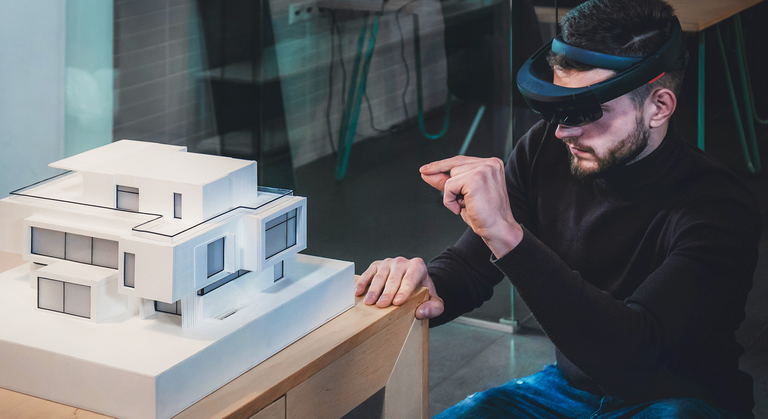
Photo Credit: Stambol
VR introduces a new set of narrative and technological guidelines, which parks a new creative direction. While VR immerses us with an imaginary environment, visible through a screen in your headset, VR is not part of an actual world outside the virtual illusions, not unless you trip over. With continued development, Augmented Reality (AR) comes to life from VR. Ar enhances how we perceive the real world by layering an artificially created environment on top of it. We may be gazing at your pet or the roadway, but we can have digital characters overlayed in it.
Some experts claim that VR is the "final media" since every media that arises maybe produce and present inside the virtual world, which has an endless possibility. Gaming is just the starting point and not a tipping point. The ability of VR to tell the story in a way that educates, inspires, and entertains us. It has limitless potential that must transcend every business and field imaginable.
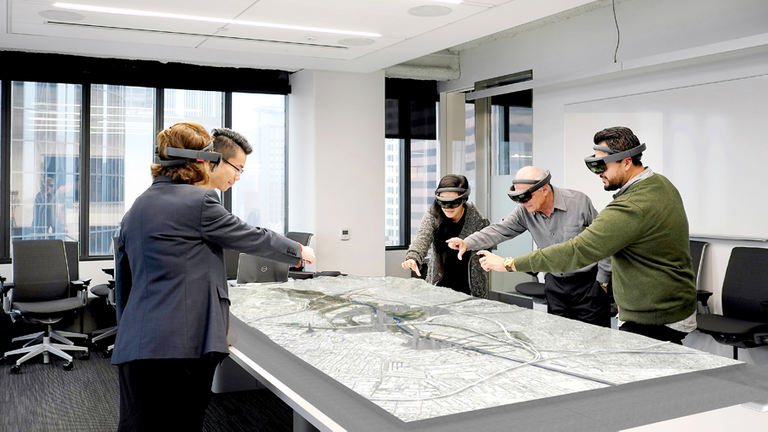
A design team at AECOM, wearing Microsoft HoloLens viewers, observes a project in AR. With the headsets, the designers are able to see data—the phases of a project, say, or flood patterns—superimposed on the model. | Phot Credit: Metropolis
Virtual Reality for Architecture
One of the main stories of the last few years has been the advent of virtual reality applications for architecture. VR would become an intrinsic component of not just presenting a project but also of the design process. No matter how great the architect and designer, it requires a leap of faith and creative imagination from customers to get them enthusiastic about the design proposal.
From early design mock-ups through project collaboration and the final touches, VR can sell a concept more effectively than any other medium. When a project is laborious, VR technology can allow several stakeholders to experience the design process and make a better avenue for debates and discussion rather than bringing all of these experts together in one room, which is time-consuming and inefficient.
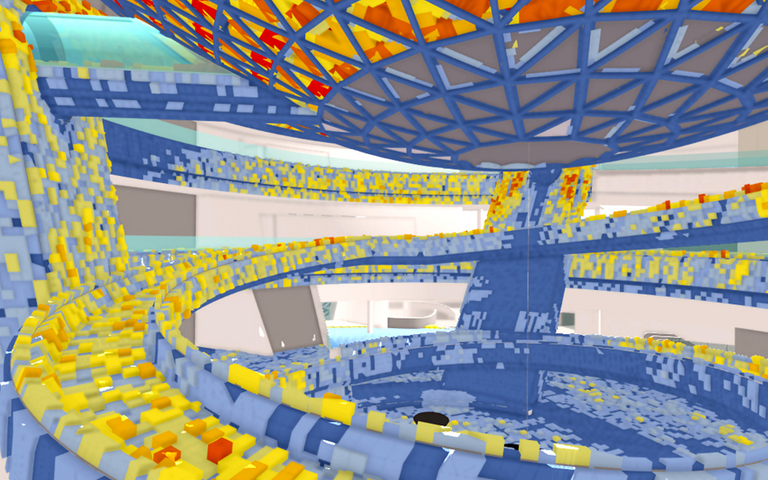
Ennead Architects has been experimenting with VR to “make the invisible visible,” in the words of partner Don Weinreich for the design of a planetarium in Shanghai. | Photo Credit: Metropolis
We can have floor plans, 3D representations, and models to communicate a conceptual design, but sometimes it fails to allow clients to understand the design concept. With VR, architects and designers can immerse the client into a fully interactive 3D environment. It boosts clients' understanding of the design and the opportunity to explore the visual representation. We may feel that how we define VR for architecture is to be superficial. However, VR will undoubtedly work well as a presentation medium for clients to grasp the design better.
We can understand how a person navigates his or her way around the structure. Also, it is now feasible to test the pathways to emergency exits using VR in architectural design, which is not possible with renderings and models. While VR is generally from computer models, VR will allow actual people to react to real-world circumstances. It enables architects to gauge how safe their design is and what modifications may be needed. These VR experiences are significantly more successful than two-dimensional representations at conveying a design's appearance and feel. VR enables clients to make more knowledgeable judgments of the overall sensory experience.
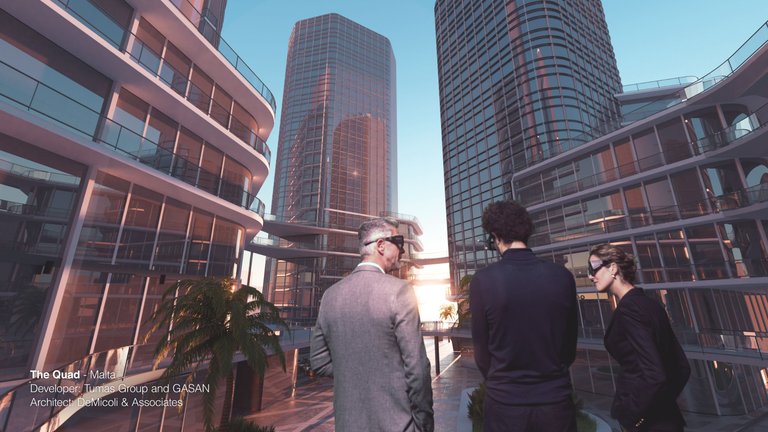
Client and architect using VR to explore The Quad -Malta design. | Photo Credit: Architizer
VR is an effective means to communicate design.
For VR to be effective, clients should fully interact with the proposed model, which has functionality that allows clients to close a door or window, turn lights on and off, and move an object in a room inside the VR environment. In this manner, clients acquire a sense of how a design would seem to scale and on a more visceral level. VR technology allows clients to engage rather than talk about the design models and plans. Architects and designers can use the clients' visual feedback to enhance the final design.
When we place clients inside a virtual and precise depiction of a building design, we can get accurate feedback. They can clearly see what they like and hate about the design, which not perceives through a floor plan or 3D model. It means less time spent back and forth tweaking designs and waiting for more feedback. We can have the client's comment in real-time. Besides, architects and designers can perform real-time modifications in the virtual world, allowing clients to acquire a feeling for aesthetic characteristics such as wall color, lighting, and even furniture.
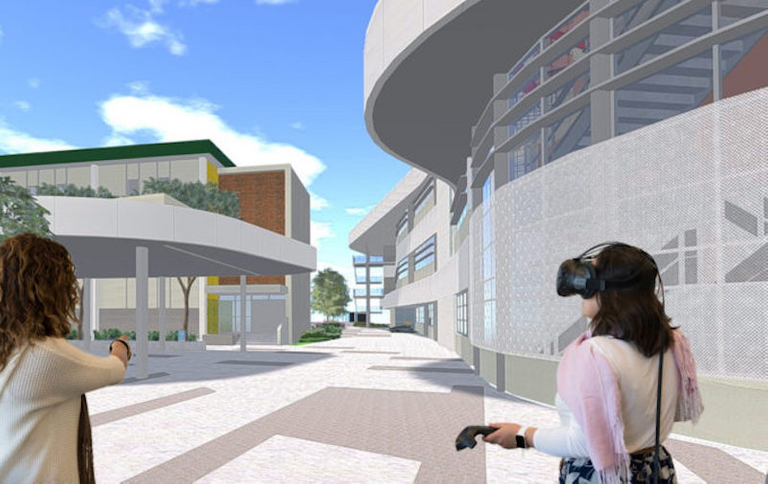
Los Angeles Unified School District (LAUSD) staff could “virtually” walk and explore their new campus. | Phot Credit: HMC Architects
VR is space with depth and movement. It is not flat icons but movable objects with people, not pictures. Architects have already begun to create virtual reality environments from their sketches, plans, and models, but not full-scale it to an interactive environment. Until recently, they worked without the VR headgear. Architects do not construct physical places and seldom ever touch construction materials. That is why architects are virtual reality designers. They created a virtual environment through papers and computers.
We are aware that architects are not a builder. They created designs and passed them on. Again, their designs in the virtual world are drawings, rendering, and models that exist through their computers but not a physical manifestation. We can see a distinct separation between the design and implementation. These potential uses for VR are not science fiction. With VR, we can speed up the architectural design process. Architects can pass the designs on to a software engineer to create the VR, enhances the design with clients' visual feedback instead of engineers building it directly. We can have a walkthrough of the design after hours rather than waiting for months or years.
Readings
- The complete guide to virtual reality – everything you need to get started
- What Is Virtual Reality? Virtual Reality is everywhere again, and that’s a problem.
- Virtual Reality Uses in Architecture and Design: VR is going to be “more powerful than cocaine”
- How virtual and augmented reality can shape architecture and design
Your content has been voted as a part of Encouragement program. Keep up the good work!
Use Ecency daily to boost your growth on platform!
Support Ecency
Vote for Proposal
Delegate HP and earn more
Its new era of technology and hopping for the best to come..
We always hope for that. Technology uplifts the way we live and not deter it.
Well done @juecoree! We're happy to inform you that this publication was especially collected and awarded RUNNER-UP in Architecture Brew #27. Congratulations!
Subscribe to Architecture+Design, an OCD incubated community.
Sounds impressive! Architectural 3D renders are becoming increasingly popular for marketing purposes, due to their ability to create stunning visuals that effectively showcase a project or product. These renders can help convey complex information to potential customers and clients quickly and clearly, as well as providing an additional layer of detail that can make a project stand out from the competition. This technology also allows architects and designers to reduce the amount of physical models they need to make and present to potential clients.
One of the main benefits of using these 3D renders is the ability to show accurate lighting and shadows, as well as other intricate details that can greatly enhance the realism of the images. This can be especially useful in helping potential clients to better envision the project or product, and can help them make a more informed decision. Additionally, 3D renders can be used to easily demonstrate different design options to a client, allowing them to make instant decisions and modifications. That is why such services like Cyber-Fox are gaining popularity https://cyber-fox.net/services/3d-architectural-rendering/3d-house-rendering/
Posted Using LeoFinance Beta